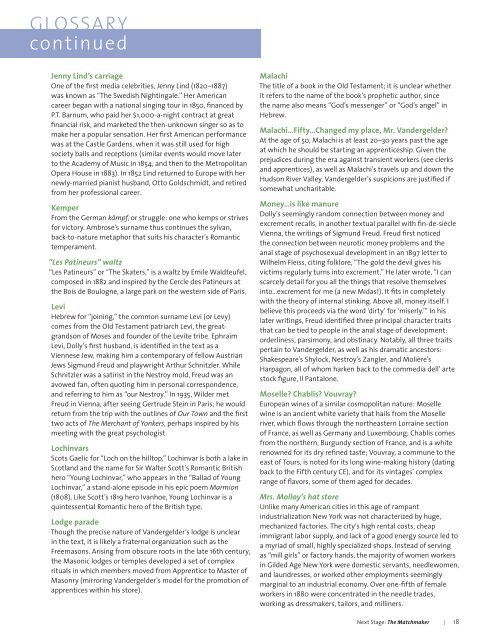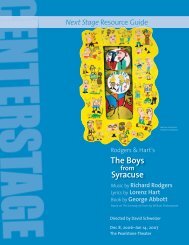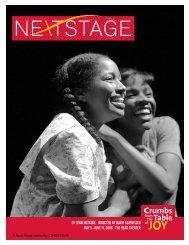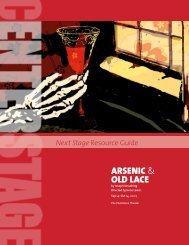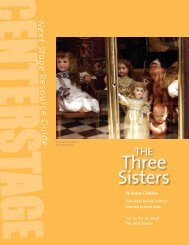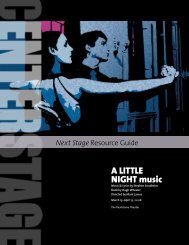The Matchmaker - Center Stage
The Matchmaker - Center Stage
The Matchmaker - Center Stage
You also want an ePaper? Increase the reach of your titles
YUMPU automatically turns print PDFs into web optimized ePapers that Google loves.
Glossary<br />
continued<br />
Jenny Lind’s carriage<br />
One of the first media celebrities, Jenny Lind (1820–1887)<br />
was known as “<strong>The</strong> Swedish Nightingale.” Her American<br />
career began with a national singing tour in 1850, financed by<br />
P.T. Barnum, who paid her $1,000-a-night contract at great<br />
financial risk, and marketed the then-unknown singer so as to<br />
make her a popular sensation. Her first American performance<br />
was at the Castle Gardens, when it was still used for high<br />
society balls and receptions (similar events would move later<br />
to the Academy of Music in 1854, and then to the Metropolitan<br />
Opera House in 1883). In 1852 Lind returned to Europe with her<br />
newly-married pianist husband, Otto Goldschmidt, and retired<br />
from her professional career.<br />
Kemper<br />
From the German kämpf, or struggle: one who kemps or strives<br />
for victory. Ambrose’s surname thus continues the sylvan,<br />
back-to-nature metaphor that suits his character’s Romantic<br />
temperament.<br />
“Les Patineurs” waltz<br />
“Les Patineurs” or “<strong>The</strong> Skaters,” is a waltz by Emile Waldteufel,<br />
composed in 1882 and inspired by the Cercle des Patineurs at<br />
the Bois de Boulogne, a large park on the western side of Paris.<br />
Levi<br />
Hebrew for “joining,” the common surname Levi (or Levy)<br />
comes from the Old Testament patriarch Levi, the greatgrandson<br />
of Moses and founder of the Levite tribe. Ephraim<br />
Levi, Dolly’s first husband, is identified in the text as a<br />
Viennese Jew, making him a contemporary of fellow Austrian<br />
Jews Sigmund Freud and playwright Arthur Schnitzler. While<br />
Schnitzler was a satirist in the Nestroy mold, Freud was an<br />
avowed fan, often quoting him in personal correspondence,<br />
and referring to him as “our Nestroy.” In 1935, Wilder met<br />
Freud in Vienna, after seeing Gertrude Stein in Paris; he would<br />
return from the trip with the outlines of Our Town and the first<br />
two acts of <strong>The</strong> Merchant of Yonkers, perhaps inspired by his<br />
meeting with the great psychologist.<br />
Lochinvars<br />
Scots Gaelic for “Loch on the hilltop,” Lochinvar is both a lake in<br />
Scotland and the name for Sir Walter Scott’s Romantic British<br />
hero “Young Lochinvar,” who appears in the “Ballad of Young<br />
Lochinvar,” a stand-alone episode in his epic poem Marmion<br />
(1808). Like Scott’s 1819 hero Ivanhoe, Young Lochinvar is a<br />
quintessential Romantic hero of the British type.<br />
Lodge parade<br />
Though the precise nature of Vandergelder’s lodge is unclear<br />
in the text, it is likely a fraternal organization such as the<br />
Freemasons. Arising from obscure roots in the late 16th century,<br />
the Masonic lodges or temples developed a set of complex<br />
rituals in which members moved from Apprentice to Master of<br />
Masonry (mirroring Vandergelder’s model for the promotion of<br />
apprentices within his store).<br />
Malachi<br />
<strong>The</strong> title of a book in the Old Testament; it is unclear whether<br />
it refers to the name of the book’s prophetic author, since<br />
the name also means “God’s messenger” or “God’s angel” in<br />
Hebrew.<br />
Malachi…Fifty…Changed my place, Mr. vandergelder?<br />
At the age of 50, Malachi is at least 20–30 years past the age<br />
at which he should be starting an apprenticeship. Given the<br />
prejudices during the era against transient workers (see clerks<br />
and apprentices), as well as Malachi’s travels up and down the<br />
Hudson River Valley, Vandergelder’s suspicions are justified if<br />
somewhat uncharitable.<br />
Money…is like manure<br />
Dolly’s seemingly random connection between money and<br />
excrement recalls, in another textual parallel with fin-de-siècle<br />
Vienna, the writings of Sigmund Freud. Freud first noticed<br />
the connection between neurotic money problems and the<br />
anal stage of psychosexual development in an 1897 letter to<br />
Wilhelm Fleiss, citing folklore, “<strong>The</strong> gold the devil gives his<br />
victims regularly turns into excrement.” He later wrote, “I can<br />
scarcely detail for you all the things that resolve themselves<br />
into…excrement for me (a new Midas!). It fits in completely<br />
with the theory of internal stinking. Above all, money itself. I<br />
believe this proceeds via the word ‘dirty’ for ‘miserly.’” In his<br />
later writings, Freud identified three principal character traits<br />
that can be tied to people in the anal stage of development:<br />
orderliness, parsimony, and obstinacy. Notably, all three traits<br />
pertain to Vandergelder, as well as his dramatic ancestors:<br />
Shakespeare’s Shylock, Nestroy’s Zangler, and Molière’s<br />
Harpagon, all of whom harken back to the commedia dell’ arte<br />
stock figure, Il Pantalone.<br />
Moselle? Chablis? vouvray?<br />
European wines of a similar cosmopolitan nature: Moselle<br />
wine is an ancient white variety that hails from the Moselle<br />
river, which flows through the northeastern Lorraine section<br />
of France, as well as Germany and Luxembourg; Chablis comes<br />
from the northern, Burgundy section of France, and is a white<br />
renowned for its dry refined taste; Vouvray, a commune to the<br />
east of Tours, is noted for its long wine-making history (dating<br />
back to the Fifth century CE), and for its vintages’ complex<br />
range of flavors, some of them aged for decades.<br />
Mrs. Molloy’s hat store<br />
Unlike many American cities in this age of rampant<br />
industrialization New York was not characterized by huge,<br />
mechanized factories. <strong>The</strong> city’s high rental costs, cheap<br />
immigrant labor supply, and lack of a good energy source led to<br />
a myriad of small, highly specialized shops. Instead of serving<br />
as “mill girls” or factory hands, the majority of women workers<br />
in Gilded Age New York were domestic servants, needlewomen,<br />
and laundresses, or worked other employments seemingly<br />
marginal to an industrial economy. Over one-fifth of female<br />
workers in 1880 were concentrated in the needle trades,<br />
working as dressmakers, tailors, and milliners.<br />
Next <strong>Stage</strong>: <strong>The</strong> <strong>Matchmaker</strong> | 1


